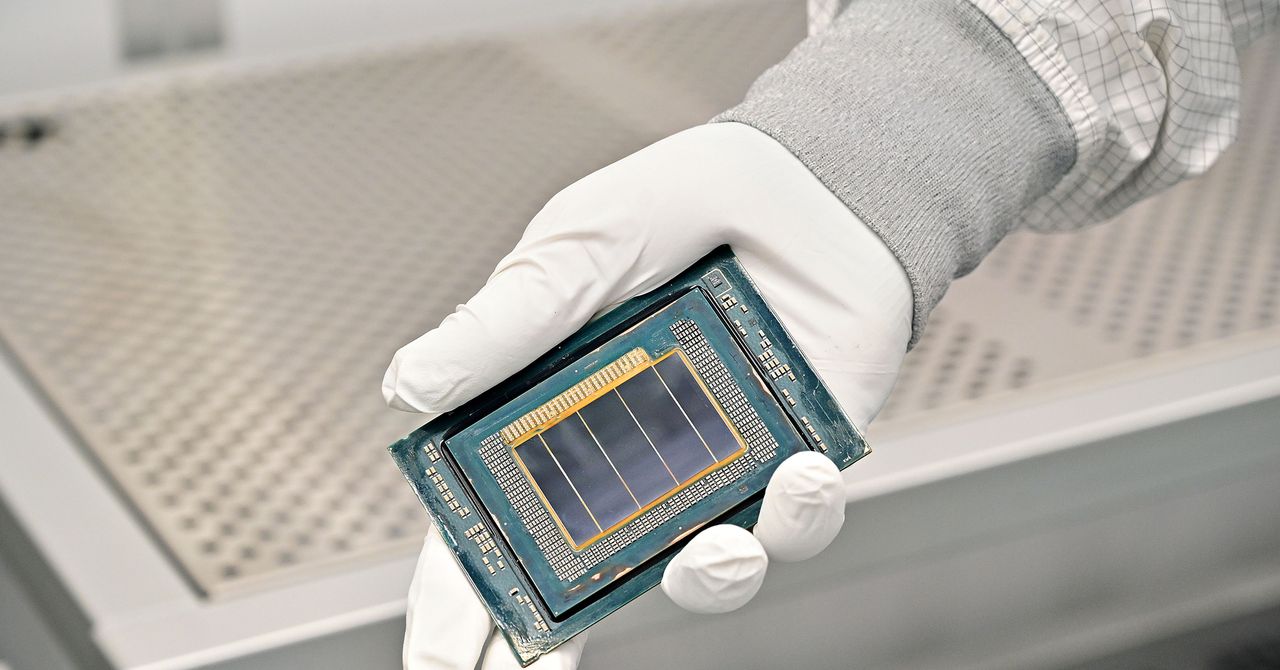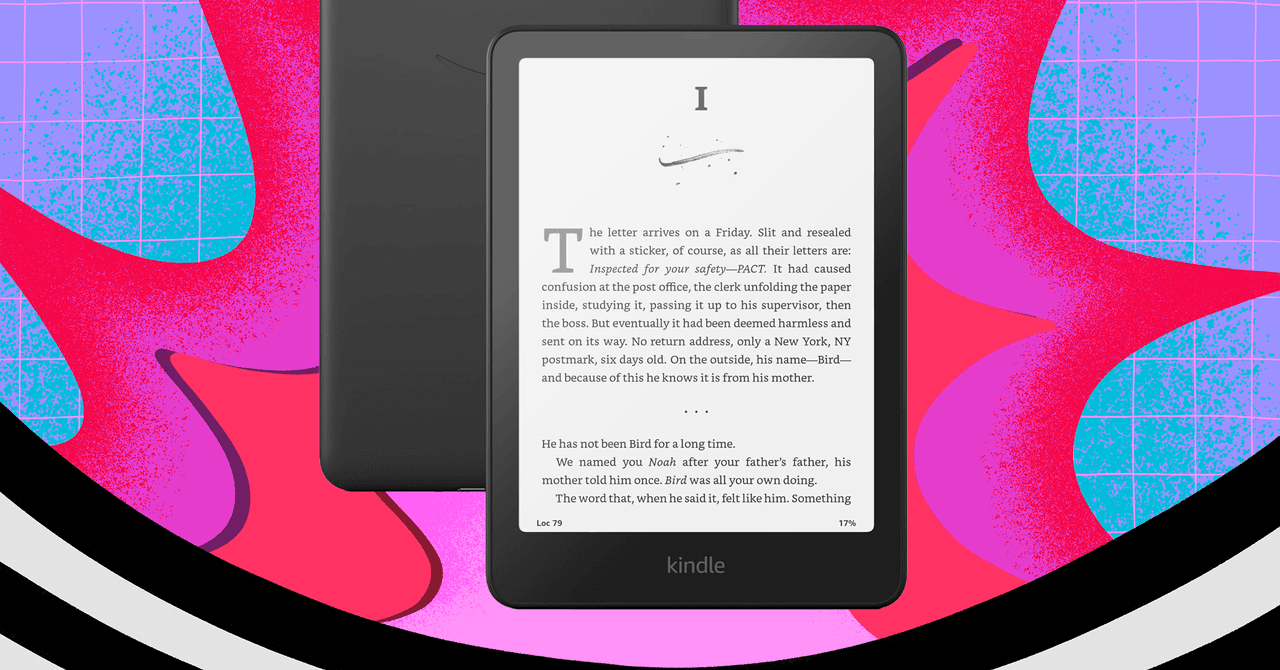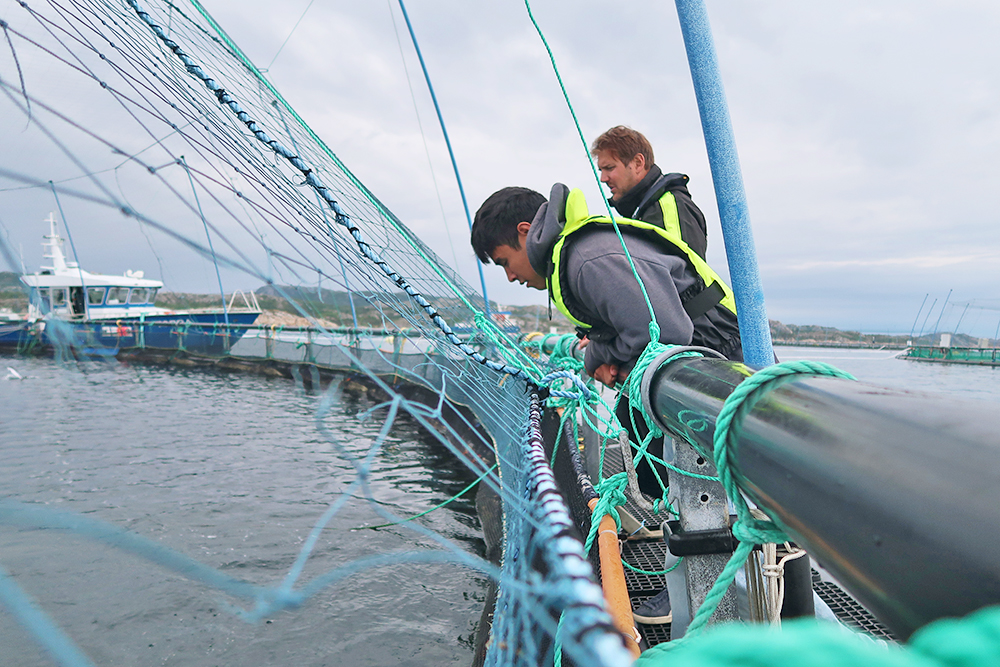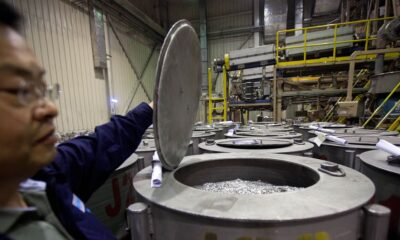Tech
Inside Intel’s Hail Mary to Reclaim Chip Dominance

Everyone who enters the fabs has to wear a bunny suit, and get dressed—or be dressed—in a clean room. Makeup, hair products, perfumes, colognes, and any aerosol products are prohibited. Workers are separated by a metallurgical hierarchy: There are those who work with copper, and those who do not. The copper people wear orange suits, not white, and have to suit up and strip down in their own clean room.
The Intel fab worker who helped me suit up proudly told me that he has done the same for two US presidents: Obama, who visited Fab 42, and Biden, who visited Fab 52 while it was under construction. As of late September, Trump still hadn’t visited, though Intel spokesperson Cory Pforzheimer said, “We’d eagerly welcome President Trump to see the most advanced R&D and leading-edge semiconductor manufacturing in the US.”
The workers shuffling around are not pulling levers and grinding away at the gears of manufacturing as much as quietly managing robots. They stand at (sterilized) computer stations while containers called front-opening unified pods, or FOUPs, whoosh by overhead through a labyrinth of robotic tracks. The rows of equipment appear endless. The floor below has been reinforced, then reinforced again, because the tiniest of shakes can ruin a whole batch of chips.
The lithography section of the facility is awash in a strange glow, which turned our white suits neon green and the copper-suited people pink. Intel demanded that the fab tourists not share the names of its suppliers, with the exception of one: ASML, the Dutch manufacturer of the world’s most cutting-edge lithography machines. WIRED witnessed two massive ASML Twinscan machines that appeared to be operational. The floor next to them was tape-marked with space for two more.
Intel has not yet publicly said how many semiconductors it expects to successfully yield, or manufacture, at Fab 52 annually. For now, the chips produced there will be used in consumer devices like laptops. But what Intel really needs is the same thing the entire industry is chasing: A hyperscaler customer, a giant data center deal, someone looking to spend billions to get an edge in AI. A whale.
Design Overhaul
Intel’s Panther Lake and Clearwater Forest chips will be made using a manufacturing process that tosses aside decades of proven design techniques in favor of two new technologies the company calls RibbonFET and PowerVia. RibbonFet is an architecture for transistors, stacking them in a way that allows for more density, while PowerVia moves the power interconnects from above the silicon stacks in the chip to below them.
Intel began working on the new design approach in 2021, and early tests have shown that RibbonFet and PowerVia led to performance gains. Reports suggest these new chips also use 30 percent less energy than the prior generation.
Tech
I Test Amazon Devices for a Living. Here’s What to Buy This Cyber Monday Weekend

Amazon steeply discounts its hardware from Black Friday through Cyber Monday, and you can still grab best Amazon and Kindle Cyber Monday deals right now. Thank goodness, because in this economy, we’ll take every discount we can get this holiday season. If you’re hoping to pick up a new Amazon device, whether it be a new Kindle for your favorite book-lover or a new Echo speaker for your smart home, this is the last great sale event of the year and the time to buy. Lots of Amazon devices we recommend are on sale, and these are the Amazon device and Kindle Cyber Monday deals you don’t want to miss.
Looking for more deals to shop? Don’t miss our guides to the Absolute Best Cyber Monday Sales, Best Cyber Monday Tech Deals, and Best Cyber Monday Digital Notebook Deals.
Updated 5 pm ET December 1: We’ve added deals on the Echo Show 8 (3rd Gen), Echo Spot, and Kids Edition Fire tablets.
Best Kindle Deals
The Kindle Paperwhite is our long-time favorite Kindle. It’s got a 7-inch screen that has an auto-adjusting warm light you won’t find on cheaper Kindles, with solid resolution, dark mode, and three months of battery life. Both the regular Paperwhite and the Paperwhite Signature are on sale, and the latter offers wireless charging and an upgraded 32 GB of storage.
This is the Kindle I find myself going back to over and over again because I love the digital notebook feature. The Kindle Scribe also has a massive (at least in the world of e-readers) 10-inch screen with an auto-adjusting front light and three months of battery, and comes with a magnet-attaching stylus to scribble notes and highlights. There’s a new Kindle Scribe due out this winter, so this might be one of your last chances to get this generation for this cheap.
Kindle finally introduced a color e-reader last year, and while it’s not our all-time favorite, it’s still a good color e-reader for anyone in the market. There are both a base model and a Signature model similar to the Paperwhite, and both models are on sale. The color screen gives your digital bookshelf and highlights a whole new life, and it’s an especially a great choice for graphic novel readers.
If you want a color Kindle for your kiddo, then this is the one to get. It comes with a fun cover to keep it safe, and a full year of Amazon Kids+ content that will give your child access to tons of age-appropriate books and other content. Honestly, if anyone should get a color e-reader, it’s kids. They’re much more likely to enjoy the color benefits than your everyday novel readers.
If you’re looking for a cheap Kindle that’s still great, the base Kindle will more than do the job. It’s smaller than the Paperwhite and Colorsoft with just a 6-inch screen, but performance is snappy and a clear upgrade to older models. You’ll still get an adjustable front light (though not warm), dark mode, 16 GB of storage, and up to six weeks of battery life.
Best Amazon Echo Deals
Amazon has four new Echo devices, and one of the best also happens to be on a small discount. The Echo Dot Max looks like a miniaturized version of the new Echo Studio, with the dust cap-style front panel and round body. Compared to past Echo Dots, the sound is seriously impressive. It comes with a higher price to match, but this small discount makes it more appealing.
Looking to spend even less? The previous reigning Echo Dot was the fifth-generation model, and it’s still a great smart speaker. You’ll get better bass than most other speakers this size, and all the benefits of Alexa in a single tiny package.
Amazon didn’t just drop new Echo speakers this year, but two new Echo Show devices as well: the fourth-generation Echo Show 8 and the Echo Show 11. Both are the same device, but the Show 11 has the larger, 11-inch display. It’s a new size for Amazon (so far, there’s been a Show 10 and a Show 15 on the larger end), and it’s already on sale. We’re still testing it, but if you think an 11-inch Alexa display would be perfect for your home, this is the perfect chance to buy.
If you’re looking for the best sound from Amazon’s arsenal, the newly updated Echo Studio has a new look but maintains the impressive sound we loved about the first generation. Not only does it have great clarity and impressive volume for its size, but it also packs spatial audio and Dolby Atmos capabilities, a built-in smart home hub, and early access to Alexa+ right out of the box.
If you want a smart speaker for your kid’s room, the Echo Dot Kids is a perfect choice. It’s our favorite speaker for kids with its fun covers, free year of Kids+ content, parental controls, and solid sound quality that has made the Echo Dot an all-around favorite for adults and kids alike.
If you want a good smart display without spending too much, my still-favored Echo Show 8 (3rd Gen) has a great discount. It’s the older model but still works great with the new Alexa+, has a built-in smart hub, and actually has better musical depth than the newer version. It’s my budget smart display pick in my guide to the Best Alexa Speakers, and it’s even cheaper right now.
This handy little partial smart screen is my favorite Alexa for bedside tables. The Echo Spot has a customizable clock face and can show you certain things, like the time of your next alarm and what song is playing, but doesn’t have a camera or a distracting slideshow like a true Echo Show device, so it’s a great in-between of a display and speaker.
Fire Device Deals
If you’re an Amazon Prime Video lover, then this is the streaming device—and the sale—for you. The Fire TV Stick 4K Max still lets you access other streaming apps, but is tailored for Amazon Prime. This second-generation model has 16 GB of storage and is easy to set up and use.
If you’re in the market for an Amazon-powered tablet, the Fire HD 8 is our favorite value option, and that’s before it went on sale. It has improved RAM at the level of our favorite Fire tablet, the HD 10, and the smaller size makes it good for traveling.
If you want a Fire tablet for your kids to stream their latest obsession (my son’s is the Pokémon movies), there are two different Kids Edition Fire tablets that are both different sizes to suit different age groups. The regular Kids Edition is for younger ones with a thicker cover and a good size for little hands, while the Pro model is best for older kids and has fun additions like Music Maker, a kid-friendly music editing app. Both models have a great sale right now.
Power up with unlimited access to WIRED. Get best-in-class reporting and exclusive subscriber content that’s too important to ignore. Subscribe Today.
Tech
MIT Sea Grant students explore the intersection of technology and offshore aquaculture in Norway

Norway is the world’s largest producer of farmed Atlantic salmon and a top exporter of seafood, while the United States remains the largest importer of these products, according to the Food and Agriculture Organization. Two MIT students recently traveled to Trondheim, Norway to explore the cutting-edge technologies being developed and deployed in offshore aquaculture.
Beckett Devoe, a senior in artificial intelligence and decision-making, and Tony Tang, a junior in mechanical engineering, first worked with MIT Sea Grant through the Undergraduate Research Opportunities Program (UROP). They contributed to projects focusing on wave generator design and machine learning applications for analyzing oyster larvae health in hatcheries. While near-shore aquaculture is a well-established industry across Massachusetts and the United States, open-ocean farming is still a nascent field here, facing unique and complex challenges.
To help better understand this emerging industry, MIT Sea Grant created a collaborative initiative, AquaCulture Shock, with funding from an Aquaculture Technologies and Education Travel Grant through the National Sea Grant College Program. Collaborating with the MIT-Scandinavia MISTI (MIT International Science and Technology Initiatives) program, MIT Sea Grant matched Devoe and Tang with aquaculture-related summer internships at SINTEF Ocean, one of the largest research institutes in Europe.
“The opportunity to work on this hands-on aquaculture project, under a world-renowned research institution, in an area of the world known for its innovation in marine technology — this is what MISTI is all about,” says Madeline Smith, managing director for MIT-Scandinavia. “Not only are students gaining valuable experience in their fields of study, but they’re developing cultural understanding and skills that equip them to be future global leaders.” Both students worked within SINTEF Ocean’s Aquaculture Robotics and Autonomous Systems Laboratory (ACE-Robotic Lab), a facility designed to develop and test new aquaculture technologies.
“Norway has this unique geography where it has all of these fjords,” says Sveinung Ohrem, research manager for the Aquaculture Robotics and Automation Group at SINTEF Ocean. “So you have a lot of sheltered waters, which makes it ideal to do sea-based aquaculture.” He estimates that there are about a thousand fish farms along Norway’s coast, and walks through some of the tools being used in the industry: decision-making systems to gather and visualize data for the farmers and operators; robots for inspection and cleaning; environmental sensors to measure oxygen, temperature, and currents; echosounders that send out acoustic signals to track where the fish are; and cameras to help estimate biomass and fine-tune feeding. “Feeding is a huge challenge,” he notes. “Feed is the largest cost, by far, so optimizing feeding leads to a very significant decrease in your cost.”
During the internship, Devoe focused on a project that uses AI for fish feeding optimization. “I try to look at the different features of the farm — so maybe how big the fish are, or how cold the water is … and use that to try to give the farmers an optimal feeding amount for the best outcomes, while also saving money on feed,” he explains. “It was good to learn some more machine learning techniques and just get better at that on a real-world project.”
In the same lab, Tang worked on the simulation of an underwater vehicle-manipulator system to navigate farms and repair damage on cage nets with a robotic arm. Ohrem says there are thousands of aquaculture robots operating in Norway today. “The scale is huge,” he says. “You can’t have 8,000 people controlling 8,000 robots — that’s not economically or practically feasible. So the level of autonomy in all of these robots needs to be increased.”
The collaboration between MIT and SINTEF Ocean began in 2023 when MIT Sea Grant hosted Eleni Kelasidi, a visiting research scientist from the ACE-Robotic Lab. Kelasidi collaborated with MIT Sea Grant director Michael Triantafyllou and professor of mechanical engineering Themistoklis Sapsis developing controllers, models, and underwater vehicles for aquaculture, while also investigating fish-machine interactions.
“We have had a long and fruitful collaboration with the Norwegian University of Science and Technology (NTNU) and SINTEF, which continues with important efforts such as the aquaculture project with Dr. Kelasidi,” Triantafyllou says. “Norway is at the forefront of offshore aquaculture and MIT Sea Grant is investing in this field, so we anticipate great results from the collaboration.”
Kelasidi, who is now a professor at NTNU, also leads the Field Robotics Lab, focusing on developing resilient robotic systems to operate in very complex and harsh environments. “Aquaculture is one of the most challenging field domains we can demonstrate any autonomous solutions, because everything is moving,” she says. Kelasidi describes aquaculture as a deeply interdisciplinary field, requiring more students with backgrounds both in biology and technology. “We cannot develop technologies that are applied for industries where we don’t have biological components,” she explains, “and then apply them somewhere where we have a live fish or other live organisms.”
Ohrem affirms that maintaining fish welfare is the primary driver for researchers and companies operating in aquaculture, especially as the industry continues to grow. “So the big question is,” he says, “how can you ensure that?” SINTEF Ocean has four research licenses for farming fish, which they operate through a collaboration with SalMar, the second-largest salmon farmer in the world. The students had the opportunity to visit one of the industrial-scale farms, Singsholmen, on the island of Hitra. The farm has 10 large, round net pens about 50 meters across that extend deep below the surface, each holding up to 200,000 salmon. “I got to physically touch the nets and see how the [robotic] arm might be able to fix the net,” says Tang.
Kelasidi emphasizes that the information gained in the field cannot be learned from the office or lab. “That opens up and makes you realize, what is the scale of the challenges, or the scale of the facilities,” she says. She also highlights the importance of international and institutional collaboration to advance this field of research and develop more resilient robotic systems. “We need to try to target that problem, and let’s solve it together.”
MIT Sea Grant and the MIT-Scandinavia MISTI program are currently recruiting a new cohort of four MIT students to intern in Norway this summer with institutes advancing offshore farming technologies, including NTNU’s Field Robotics Lab in Trondheim. Students interested in autonomy, deep learning, simulation modeling, underwater robotic systems, and other aquaculture-related areas are encouraged to reach out to Lily Keyes at MIT Sea Grant.
Tech
Wake Up—the Best Cyber Monday Mattress and Bedding Sales Are Here

If you’ve been dreaming all year of saving serious cash on a new mattress, you have a few more hours before the alarm goes off. From the best mattresses for back pain to our favorite cooling options, these are the top deals on mattresses the WIRED Reviews team has tested in their own homes. We also track prices all year to see where the best sales are really happening. And Cyber Monday brings some of the best sleep deals you’ll see all year.
If it’s on this list, it’s genuinely a good deal on a product someone from our team has tested and approved of. While the prices listed below are for queen sizes, the deals should apply to all mattress sizes. Your dreams of a new king mattress are still going strong.
Updated 2 pm ET December 1: We’ve added new sales from Sleep Number and Thuma, and ensured up-to-date links and prices.
WIRED Featured Deals
Bear
The WIRED Reviews team has crowned the Bear Elite Hybrid as the best mattress for back pain we’ve tested to date. It comes in three firmness options, including Soft, Medium, and Firm. WIRED testers have found Firm helpful for spinal alignment, and you can also add a Celliant cover for a fee, designed to help with muscle recovery. In addition to the sale, Bear is also throwing in a free accessories bundle (two pillows, a sheet set, and a mattress protector). Use WIRED40 for 40 percent off, which is an additional 5 percent off the offer you’ll see on the site.
Helix
We test many, many mattresses—so it’s saying something that the Helix Midnight Luxe has been our favorite overall mattress for seven years running. This specific model is designed for side sleepers, but the brand’s slogan is “designed for every body,” and there are plenty of options for every sleeping position. Helix’s Cyber Week sale is underway, but you can get additional savings by using our exclusive coupon code WIRED27 for 27 percent off.
Saatva
Saatva mattresses strive to be the intersection of luxury, natural materials, and support for many sleepers. One model in particular that we’ve tested, the Saatva Rx, offers serious pressure relief for even the most persistent aches and pains. It incorporates micro coils and pressure-relief foam, so the price is usually on the higher side. However, Saatva’s holiday sales promo should take some strain off your wallet, as you can save $400 off purchases of $1,000 or more. Use our link below.
Sleep Number
If you’re trying to decide between a sleep tracker or a new mattress, I’ve got news for you—Sleep Number can do both. The p6 is a smart bed that lets you adjust your preferred firmness; pressure relief levels; and, paired with an adjustable base, the angle of the head and foot of the bed. It also tracks your sleep, noting any changes in your heart rate, breathing, and deep sleep. Sleep Number is offering free shipping plus discounts for bed and base bundles. Free shipping’s a big deal because it’s usually a separate fee from Sleep Number for a team to come set up the bed for you. Now, it’s just part of your purchase.
Casper
Amazon’s current price on this Casper hybrid is slightly lower than we saw for Prime Day, at just over $1,000 for a queen from Amazon. Casper was one of the original American mattresses-in-a-box makers, though the company has been bought and sold a few times. We like this mattress for pressure relief but it has heightened support thanks to the coils. There’s also a sale on a Casper pillow we like below.
Birch
If you’re looking to get memory foams and other man-made materials out of your bedroom in favor of an all-organic mattress, the Birch Luxe Natural has been a consistent winner for us. It has an organic cotton Euro top that gives your pressure points a cushioned surface to slightly sink into. Layers of natural wool are incorporated underneath for breathable temperature control. Latex is pressure-relieving, like memory foam, but without any chemicals involved. It’s also organic, with Global Organic Latex Standard (GOLS) certification. Pocketed coils help support you where you need it most. Birch is also throwing in two free pillows with every mattress purchase. To make it even better, you can use code WIRED27 for even more savings.
Airweave
There is a significant savings on a mattress we really liked for its firmness and portability, while balking at the price in our review. The Airweave’s filling is made from a unique ultrafine woven polyethylene, which looks like uncooked glass noodles or a tangle of fishing line. It functions like super micro coils and offers a somewhat stiff but very. supportive sleeping surface. Best of all, it can be disassembled for easy moving, and the cover is washable.
Silk & Snow
Canadian brand Silk & Snow uses high-quality materials and thoughtful construction in its mattresses, with prices that are hard to argue with. In the S&S Organic hybrid’s case, there are several organic certifications too. With GOLS-certified organic cotton, organic wool, and GOLS-certified latex atop pocketed coils, it eliminates any guesswork about materials and focuses solely on support. For holiday shoppers, Silk & Snow is offering up to $300 off on mattresses, no code needed.
Avocado
Avocado takes the notion of “all-natural” mattresses very seriously, with an extensive list of certifications to back its claims. The Avocado Green hybrid mattress comes in Firm (base model), Medium (pillow top), and Plush (box top, which is an even thicker version of a softer pillow top). Medium and Plush cost a bit extra, but we previously tested the Firm model and loved it. Its organic latex and coil construction provided lumbar support, temperature regulation, and pressure relief to the point where it got a near-perfect score. For Avocado’s holiday mattress sale, you can take 20 percent off your purchase, no code needed.
Wolf
Wolf mattresses are not ones you should overlook. Each time our team has tested a Wolf mattress, we were impressed with its quality and performance. The Wolf 13-Inch Memory Foam Hybrid Premium Firm Mattress is quite a name, but this hybrid mattress excels with temperature control thanks to a cooling cover, foams, and coils. It’s just firm enough that you can move around without feeling stuck, and it also maintains spinal alignment. Wolf’s Cyber Week mattress sale is now live, with 15 percent off on your purchase.
Tiami
Tiami’s Luxury Hybrid has a firmer feel with cushioning memory foam layers and unique, foam-capped coils that help relieve pressure around your joints. It’s a specialty mattress through and through, which makes Tiami’s current mattress sale even more enticing. It’s the lowest price we’ve seen all year, thanks to its Cyber Monday promo at 40 percent off, no code needed.
Essentia
You’re searching high and low for an organic mattress, but not just any organic mattress will do—it has to be vegan as well. (Many organic mattresses aren’t vegan due to the inclusion of wool.) For those who aim to live (and sleep!) by vegan protocols, Essentia’s Tatami mattress is right up your alley. It’s got organic cotton, organic latex, and organic foam all meant for pressure relief, temperature control, and strong lumbar support. Essentia is offering 25 percent off mattresses plus two free pillows as part of its holiday mattress sale. (Discount reflected in cart.)
Naturepedic
Naturepedic checks a lot of boxes with its EOS Classic mattress. It’s got customizable firmness on each side of the mattress. It’s one of the best mattresses we’ve tested to date. It’s also made with organic materials, making it one of the best organic mattresses we’ve come across. Naturepedic is offering 20 percent off sitewide and throwing in a free accessories bundle (organic mattress protector and pillows) on orders of $699 or more.
Leesa
Leesa’s Sapira Chill Hybrid ranks as one of the best mattresses by our account (more specifically, the best hybrid mattress), thanks to its cooling and lumbar support. It features a quilted pillow top with a cooling cover, along with pressure-relieving foams and pocketed coils. There are three firmness levels to choose from, but if you have back pain, you may want to opt for something firmer to support spine alignment. Plus, the Sapira Chill’s pillow top will soften things out a bit. While the price for this mattress isn’t the lowest we’ve seen this year, Leesa’s holiday sale is pretty good. You can take 30 percent off select mattresses, including the Sapira Chill.
Plank
For those who feel like a mattress is never quite firm enough, the Plank Firm is one of the team’s favorite beds that delivers a truly firm feel. It’s actually dual-sided, with one side “firm” and the other “extra firm,” so you can get the utmost, unyielding support. It’s been a hit with some of our testers who have back pain and look to firm beds to maintain spine alignment. To keep your wallet balanced, too, Plank is offering 30 percent off with code BFRIDAY30.
Cyber Monday Bedding Deals
No new mattress setup would be complete without sheets, pillows, bed frames, and sleep accessories. Cyber Monday is the time to get the best of the best, and these are deals we’re pretty hyped about.
Thuma Signature Bed Frame
We’re big Thuma fans around here, from the Thuma Hybrid mattress to its Classic Bed frame (review coming soon!). We wish these two items were on sale for Black Friday, but Cyber Monday is a new day with new opportunities, like a sale on Thuma’s Signature Bed frame. Just like the Classic Bed, the Signature Bed frame is a cinch to set up and comes in either soft Italian felt or performance linen. Thuma is offering up to 22 percent off the Signature Bed as part of its Cyber Monday sale.
Casper Sleep Hybrid Snow Pillow
Another Casper sale you’ll find on Amazon, reviewer Nena Farrell found this pillow had a lower loft paired with a firmer feel. These are both aspects that stomach sleepers need from their pillows to prevent disturbing their neck’s cervical alignment and causing trouble with their lower backs.
My Green Mattress
You’re looking for a quick hack to revitalize your mattress’s support—before your guests arrive for the holidays. Mattress toppers can help buy you some time while increasing pressure relief, support, and overall comfort. This organic latex mattress topper from My Green Mattress has two inches of firmer-feeling, GOLS-certified Dunlop latex. For the holiday, you can get 15 percent off sleep accessories, including this organic latex topper.
Helix
Here’s another hypothetical for you, based on personal experience: You know someone living in a dorm, and their mattress just straight-up sucks. Sleep’s crucial for these scholars, and Helix’s GlacioTex Memory Foam Topper is designed to provide pressure relief and temperature regulation to help elevate the lowliest of dorm-room beds (aka, a glorified piece of foam wrapped in a tarp). Use code WIRED27 for 27 percent off this topper.
Cozy Earth
We’re covering all sorts of Cozy Earth deals right now. But these bamboo sheets are so lovely, we’re giving them a shoutout twice. If you’re still struggling with gift ideas, these sheets are a cooling, luxurious option the recipient will use often (at least, I’d sure use them). Plus, the limited edition seasonal patterns are too whimsical to pass up. These sheets are currently 45 percent off and are selling out quickly.
Brooklinen
If you crave the experience of being wrapped in something similar to a fluffy cloud, chances are you’d really like a down comforter. WIRED reviewer Louryn Strampe likened Brooklinen’s all-season down comforter to something you’d see in a hotel, with its starchy cover and fluffy fill. Brooklinen is continuing its 25 percent off sitewide sale from Black Friday through Cyber Week.
Coop
The first time I technically tested this crescent pillow was in a friend’s guest room, and I’ve been a fan ever since. This adjustable pillow’s bottom has an arch, allowing your shoulders to press into the pillow and providing more cushion around your neck. You can also add fill (which comes in a separate bag) to make it firmer, or take some out to increase softness. You can take 25 percent off as part of its current sitewide sale.
Power up with unlimited access to WIRED. Get best-in-class reporting and exclusive subscriber content that’s too important to ignore. Subscribe Today.
-

 Sports1 week ago
Sports1 week agoWATCH: Ronaldo scores spectacular bicycle kick
-

 Entertainment1 week ago
Entertainment1 week agoWelcome to Derry’ episode 5 delivers shocking twist
-

 Politics1 week ago
Politics1 week agoWashington and Kyiv Stress Any Peace Deal Must Fully Respect Ukraine’s Sovereignty
-

 Business1 week ago
Business1 week agoKey economic data and trends that will shape Rachel Reeves’ Budget
-

 Politics1 week ago
Politics1 week ago53,000 Sikhs vote in Ottawa Khalistan Referendum amid Carney-Modi trade talks scrutiny
-

 Tech6 days ago
Tech6 days agoWake Up—the Best Black Friday Mattress Sales Are Here
-

 Tech1 day ago
Tech1 day agoGet Your Steps In From Your Home Office With This Walking Pad—On Sale This Week
-

 Fashion1 week ago
Fashion1 week agoCanada’s Lululemon unveils team Canada kit for Milano Cortina 2026

























-SOURCE-Nena-Farrell.jpg)






-SOURCE-Nena-Farrell.jpg)

-SOURCE-Nena-Farrell.jpg)




.jpg)
-Partner-Photo-SOURCE-Wired-(edited-R0000095).jpg)
-SOURCE-Nena-Farrell.jpg.jpg)




.jpg)


-Reviewer-Photo-SOURCE-Scott-Gilbertson.jpg)
-Reviewer-Photo-SOURCE-Scott-Gilbertson.jpg)
-82.jpg)









.jpg)

.jpg)
.jpg)



.jpg)



-Reviewer-Photo-SOURCE-Louryn-Strampe.jpg)




